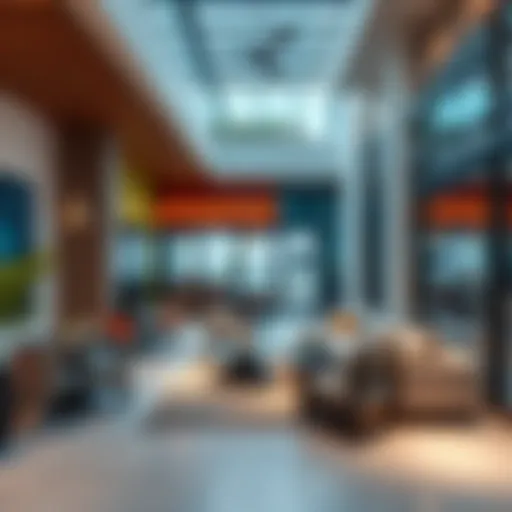Architectural Insights into the HassaniCor Building
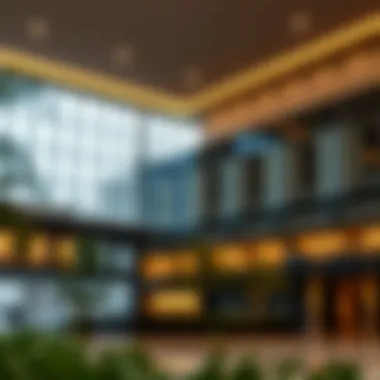

Intro
The emergence of Dubai as a global metropolis is juxtaposed with its distinctive architectural ventures, with the HassaniCor Building standing out as a beacon of contemporary design and urban innovation. Within the shimmering skyline, this edifice doesn't merely add to the aesthetic allure; it mirrors the relentless pursuit of progress that shapes the city's identity. As the sands of time shift, the architectural language of Dubai is evolving, influenced by market dynamics that engage not just the eye but also the intellect of investors, professionals, and homebuyers alike.
Exploring the architectural essence of the HassaniCor Building goes beyond the physical structure. It unravels how design philosophies mesh with socio-economic contexts, reflecting the city's thriving real estate landscape. In this article, we will dissect these elements, breaking down their significance into digestible insights.
Through this exploration, readers will gain a comprehensive understanding of the building's structural and aesthetic value while acknowledging its role in the local market and its social implications. As we navigate through the details, various trends, and investment opportunities tied to this remarkable addition to Dubai's architectural narrative will also be illuminated, providing both professionals and potential buyers with a toolkit for informed decisions.
Preface to the HassaniCor Building
The importance of discussing the HassaniCor Building cannot be understated, especially in the context of Dubai's architectural evolution. This structure encapsulates a blend of modern aesthetics and functional design, making it a significant landmark in the city’s ever-evolving skyline. Understanding its architecture offers insights into current trends, sustainable practices, and the socio-economic fabric of the locality.
The HassaniCor Building stands not just as a piece of real estate but as a symbol of innovation and community integration. As urban areas become more crowded, such projects demonstrate how architectural excellence can address both aesthetic and practical concerns. In an era where designs must seamlessly blend with environmental considerations, the HassaniCor serves as a prime example of this delicate balance.
Overview of the Project
The HassaniCor Building is a testament to meticulous design and planning, with its conception arising from the need for modern commercial and residential spaces in Dubai. The project was initiated to meet the demands of a growing population and an ever-burgeoning market, aiming to forge a space that facilitates both work and leisure. With its unique architectural features, the building is not only visually striking but also emphasizes functionality and accessibility.
Whether one looks at it from an investor's perspective or a local resident’s point of view, the building is set to play a pivotal role in shaping the dynamics of urban living. Its innovative design approach includes mixed-use spaces that cater to diverse segments of the market, from retail outlets to luxury apartments, making it a hotspot for both business and community engagement.
Location and Accessibility
Strategically located, the HassaniCor Building offers easy access to major transport links and urban amenities. Situated near key thoroughfares, residents and visitors can navigate the bustling city with relative ease. The integration with public transport systems enhances its appeal, ensuring connectivity to various parts of Dubai, which is crucial for both daily commuters and visitors.
The locality surrounding the building is ripe with opportunities, featuring parks, cultural venues, and shopping centers, creating a vibrant atmosphere conducive to both work and social activities. This connectivity not only enriches the experience of living or working in the building but also adds to its market value, making it an attractive proposition for real estate investors.
In summary, the HassaniCor Building stands at the crossroads of innovative design, strategic location, and community access. It promises to make a mark not only as an architectural marvel but also as a pivotal part of Dubai's urban landscape.
Architectural Design and Philosophy
The architectural design and philosophy embodied in the HassaniCor Building are cornerstones that define not only its physical presence but also its role within the urban landscape of Dubai. Understanding these aspects is crucial as they provide insights into how this skyscraper fulfills aesthetic, functional, and social aspirations in a rapidly evolving city.
A well-conceived architectural design serves as a bridge between the past and the future, harmonizing tradition with progress. The central tenet of the HassaniCor design reflects the intent to integrate with the culture and environment of Dubai while showcasing innovation. This blend enhances the building's appeal, capturing the imagination of residents and tourists alike.
Design Concept and Aesthetic Values
The design concept of the HassaniCor Building is a marriage of modernity and traditional Middle Eastern motifs, offering a fresh perspective on contemporary architecture. While towering structures often focus solely on height and commercial viability, this building draws heavily from local designs and ethos, infusing elements that resonate with the community.
The rounded facade, for instance, pays homage to traditional Islamic art while incorporating sleek glass panels that reflect the dynamic skyline. Such design not only enhances visual allure but also serves practical purposes—like minimizing wind resistance. Additionally, the building's strategic orientation maximizes natural light and provides exceptional views of the Dubai landscape.
The following points summarize the aesthetic values of the HassaniCor Building:
- Symmetry and Proportion: The design adheres to principles of balance and harmony, creating a pleasing aesthetic.
- Materiality: Using a combination of glass, steel, and locally-sourced materials conveys authenticity while promoting sustainability.
- Landscaping Integration: Surrounding green spaces encourage biodiversity and promote mental well-being among occupants.
"Architecture should speak of its time and place, but yearn for timelessness." — Frank Gehry
Sustainable Building Practices
The commitment to sustainability in the construction of the HassaniCor Building distinguishes it in a market increasingly driven by environmental concerns. The project emphasizes energy efficiency and responsible resource usage, aligning with Dubai's goal of becoming smarter and greener.
Incorporating renewable energy sources, such as solar panels, significantly reduces the building's carbon footprint. Rainwater collection systems contribute to water conservation, while advanced HVAC systems optimize energy consumption. The design also emphasizes thermal insulation, which plays a crucial role in maintaining comfortable indoor climates without excessive reliance on air conditioning.
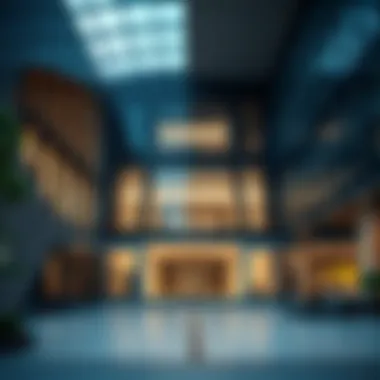
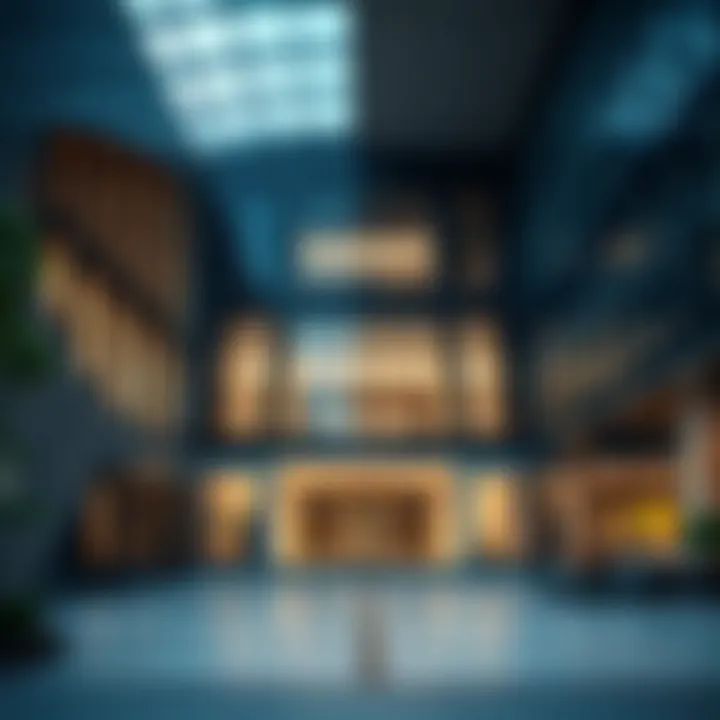
Key sustainable features include:
- Green Roofs and Vertical Gardens: These not only tackle urban heat but also enhance biodiversity.
- Smart Building Technology: Integrating IoT solutions allows for real-time monitoring of energy use and environmental impact.
- Certification: Targeting a LEED (Leadership in Energy and Environmental Design) certification underlines the project's commitment to sustainability.
In summary, the architectural design and underlying philosophy of the HassaniCor Building concatenate aesthetic beauty with pragmatism and sustainability, establishing a model for future developments in Dubai and beyond. This commitment influences local design standards and raises public awareness of the importance of integrating nature and community values into urban environments.
Structural Features and Innovations
When discussing a building as iconic as the HassaniCor Building, understanding its structural features and innovations becomes indispensable. The architectural language of a project, especially one in a thriving metropolis like Dubai, speaks volumes not just about aesthetic values but also about functionality, safety, and eco-friendliness. This section deconstructs those fundamental aspects that lay bare the ingenuity housed within this towering structure.
Materials Used in Construction
The choice of materials utilized in the construction of the HassaniCor Building is a testament to contemporary engineering and design thinking. What’s more, the materials chosen are reflective of both performance and sustainability.
- High-Strength Concrete: This material is favored for its durability and ability to withstand harsh weather conditions common in Dubai. The building’s ability to resist heat and maintain indoor cooling is largely attributed to this selection.
- Glass Facades: Aesthetically appealing, the extensive use of glass not only amplifies natural sunlight to enhance interior spaces but also allows for a seamless integration of the skyline with the building's exterior. The glass used has insulation properties which also help in energy conservation.
- Steel Framework: The structural integrity comes largely from its steel skeleton, which enables large open spaces within the building. This innovation allows for flexible interior layouts, catering to varied tenant needs.
The blend of these materials reflects a harmonious approach, integrating sustainability with modern aesthetics. It may seem like a minor consideration, but the strategic selection of materials significantly contributes to the marketability of the building in a competitive real estate market.
Engineering Challenges and Solutions
The construction of the HassaniCor Building was not without its hurdles. Like trying to fit a square peg in a round hole, engineers faced various challenges that required innovative solutions.
One key issue was the extreme weather conditions prevalent in Dubai. Engineers had to ensure that the design could withstand high winds and heat. To combat these challenges, the design team employed advanced simulation software to carry out stress tests on materials and structural integrity.
Another significant challenge revolved around the limited construction timeframe. To stay on schedule without compromising quality, a project management approach known as "just-in-time" was utilized. This strategy minimized waste and ensured that materials were delivered exactly when needed, streamlining the overall process.
"Addressing these engineering challenges showcased the adaptability and resilience that the HassaniCor project embodies, transforming potential setbacks into innovative triumphs."
Economic Impact of the HassaniCor Building
The HassaniCor Building stands as a pivotal contributor to the economic landscape of Dubai, influencing various sectors in both direct and indirect ways. Understanding the economic implications of this architectural structure involves assessing its market value and the broader consequences on the local real estate game. As urbanization in Dubai accelerates, it becomes essential to evaluate how such developments shape the economic structure around them.
Market Value and Investment Potential
The market value of the HassaniCor Building does not merely reflect its physical presence but embodies the overall promise and trajectory of real estate investments in Dubai. As developers eye this skyline marvel, its allure resonates well with high-end buyers and seasoned investors alike. The potential for capital appreciation is significant, driven by the building’s innovative design, strategic location, and the amenities it provides.
- Investment Atrractiveness: Investors often seek out properties that not only enhance their portfolio but provide stable returns. The HassaniCor Building, with its eye-catching architectural features, positions itself as a hallmark of modern living in Dubai. Many consider it a prime area for long-term investment because of its potential for value growth.
- Rental Market Dynamics: The distinctiveness of HassaniCor translates into potential rental premiums, signifying that demand will outstrip supply. Properties like this often see a lower vacancy rate, making it an appealing choice for rental income.
- Catalyzing Further Investments: Surrounding infrastructure improvements, spurred by the needs of this landmark, can lead companies to invest further in the vicinity. Such ripple effects create an ecosystem of economic growth, impacting local businesses and creating job opportunities.
Impact on Local Real Estate Prices
The advent of the HassaniCor Building has noticeable consequences on real estate pricing in its immediate area and beyond. Properties nearby have been poised to see a rise, reflecting a positive correlation between significant developments and property values.
- Comparative Price Analysis: Areas near the HassaniCor have already started experiencing noticeable increases in property prices. Real estate agents are closely monitoring how comparable properties perform. This kind of comparative analysis can serve as a predictive tool for future buyers.
- Gentrification Effects: With the construction of sophisticated projects, there is often a sense of gentrification. Existing residents and businesses may experience changes in their surroundings, resulting in higher costs and availability of amenities. The gentrification wave can alter the socio-economic fabric of the community, thereby reshaping it.
"Ambitious buildings like the HassaniCor are not just structurally impressive; they are economic engines that can uplift an entire neighborhood."
- Creating New Market Segments: The high-end nature of HassaniCor invites new market segments. Luxury goods retailers and service providers may seek to establish businesses to cater to the upscale residents and visitors drawn to the property.
Community and Social Significance
The community and social significance of the HassaniCor Building plays a crucial role in understanding its impact on the urban landscape of Dubai. This section explores how the building integrates into the local environment, promotes community engagement, and enhances the quality of life for its residents and visitors.
Integrating into the Urban Fabric


The HassaniCor Building stands as more than just a remarkable structure; it symbolizes a connection between architecture and the community it serves. With its strategic location set against the backdrop of Dubai's dynamic skyline, the building is designed to foster a sense of belonging and accessibility. The layout enhances pedestrian pathways and encourages foot traffic, making it easier for locals and tourists alike to interact with the surrounding neighborhoods.
One of the key considerations in the integration of the HassaniCor Building is its regard for the existing architectural rhythm of Dubai. Its facade harmonizes with neighboring structures, ensuring it doesn't disrupt the area's aesthetic. The inclusion of landscaped areas and open plazas highlights an intention to invite community gathering and interaction. Furthermore, spaces are allocated for pop-up markets and cultural events, effectively turning the building into a hub of activity and bringing vibrancy to the environment.
- Connecting with the Local Culture: Efforts have been made to incorporate elements reflective of Emirati heritage, from intricate patterns inspired by traditional designs to community art installations.
- Enhanced Mobility: The construction promotes walkability through connected bike lanes and pedestrian-friendly zones, fostering a healthier lifestyle and encouraging sustainable modes of transportation.
Public Spaces and Amenities
The design of the HassaniCor Building emphasizes the importance of public spaces that prioritize community interaction. By integrating various amenities that cater to diverse groups, the building enhances both practical and recreational experiences for residents and visitors.
Within the structure, expansive public spaces, such as green roofs and community gardens, provide areas for relaxation and leisure, while also promoting environmental sustainability. These spaces serve as open-air venues for communal activities such as yoga classes and art exhibitions. Additionally, shaded seating areas encourage informal gatherings, creating opportunities for socializing and building relationships among diverse groups.
Some notable features include:
- Community Rooms: Facilities are available for workshops and meetings, providing residents with resources for learning and collaboration.
- Children's Play Areas: Specially designed zones ensure kids have safe and engaging spaces to explore, fostering community ties among families.
- Cafés and Restaurants: Local businesses find their place within the building, encouraging support for the local economy while providing dining options that foster interaction.
"Community is much more than belonging to something; it's about doing something together that makes belonging matter." - Brian Solis
Regulatory and Compliance Aspects
In the world of construction, regulatory and compliance aspects are paramount. They ensure that every building not only meets aesthetic criteria but also adheres to legal, safety, and environmental standards. This is especially crucial for structures like the HassaniCor Building, which make a significant mark on the urban landscape of Dubai.
By aligning with regulatory requirements, developers avoid potential legal pitfalls and enhance the building's overall value. Additionally, fulfilling these regulations fosters trust with buyers and investors, who feel reassured that the structure has been constructed following the highest standards.
Building Codes and Safety Standards
Building codes are the backbone of construction protocols. They dictate everything from design, material selection, structural integrity, to fire safety measures. For the HassaniCor Building, compliance with local building codes ensures that it withstands Dubai's unique climate and seismic activity.
Moreover, safety standards revolve around protecting occupants and the surrounding community. For example, the HassaniCor Building likely incorporates:
- Fire safety precautions such as sprinkler systems and smoke detectors.
- Structural assessments to address wind and earthquake resistance.
- Accessibility features, ensuring compliance with universal design principles.
Ensuring these elements are in place not only protects lives but also enhances the marketability of the property
Zoning Regulations and Approvals
Zoning regulations dictate the specific uses for land within a municipality. They can affect everything from the building's height to its purpose. The HassaniCor Building had to navigate various zoning laws that shape its role in the urban fabric of Dubai.
Obtaining the necessary approvals can be a complex affair. For instance, if the building were to exceed a certain height, it would have to meet more stringent requirements than lower structures. Additionally, the building may need to allocate specific spaces for public use, like parks or pathways, as per zoning restrictions.
Understanding these zoning regulations can also provide insight into potential future developments in the area. As Dubai continues to develop, you may find that such regulations are periodically revised, reflecting the city’s ambitions for growth and sustainability.
"Adhering to regulatory and compliance aspects not only prevents legal repercussions but it also creates a framework of trust within the community."
Challenges Faced During Construction
Building the HassaniCor structure did not come without its hurdles. Each challenge presented a lesson, a chance to innovate, and a mosaic of experiences that would eventually shape the final product. Understanding these obstacles is essential not only for appreciating the brilliance of the HassaniCor design but also for recognizing the complex environment that characterizes construction in modern urban landscapes like Dubai.
Logistical and Supply Chain Issues
Logistics during construction often feels like solving a Rubik's cube — many moving parts that need to come together in perfect alignment. The HassaniCor project was especially demanding due to the rapid pace of Dubai’s development. Key materials such as steel, glass, and concrete, sourced from local and international suppliers, faced severe delays.Transportation in a bustling metropolitan area isn’t a stroll in the park; it’s often laden with restrictions and timing challenges.
The need for precise timing was crucial. Cranes, trucks, and laborers all awaited specific materials, and if one link in this chain faltered, it threatened to halt the entire project. This bottleneck not only affected supply but also added chaos to the project timeline. To counteract these hurdles, the project managers used technology efficiently, implementing tracking systems to monitor the movement of materials in real-time.

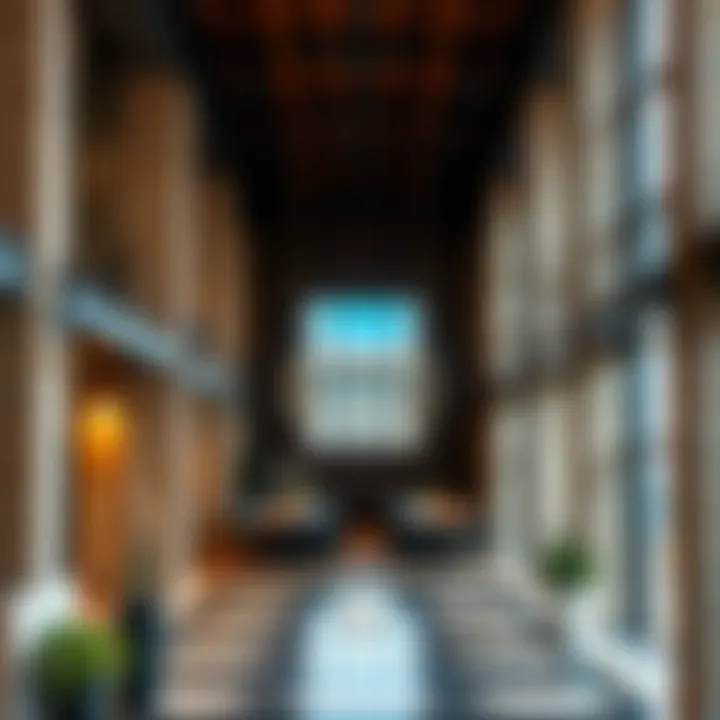
- Key materials affected include:
- Steel needed for structural frames
- Glass that allows natural light into the space
- Specialized concrete for various designs
Furthermore, local weather conditions played a critical role. The intense heat during summer months in Dubai can cause delays, affecting not just workers but also the curing processes of certain materials. The lessons learned have set new benchmarks for future projects aiming for similar designs and timelines in this challenging environment.
Managing Timelines and Budgets
Time and budget go hand in hand in construction; think of them as dance partners. When one is stepped on, the other inevitably feels the fallout. For the HassaniCor Building, budget overruns became a reality almost from day one. Unforeseen costs arose from logistical delays and the necessity to source higher-quality materials at a premium.
Maintaining a fluid budget is essential. The project managers had to implement contingency strategies to keep financial projections aligned with the actual expenditures. Monthly meetings became the norm, where stakeholders would scrutinize line items and assess priorities. Both transparency and adaptive planning emerged as indispensable tools during these discussions.
- Strategies included:
- Reassessing resource allocation
- Exploring local suppliers to cut costs
- Utilizing pre-fabricated components to save time
Maintaining timelines posed its own challenges. With delays woven into the fabric of the construction process, managing client expectations alongside realistic goal-setting became vital. Regular communication with investors and community stakeholders kept disgruntlement at bay. This proactive approach not only heralded a smoother ride through construction challenges, but it also created a solid foundation of trust between the builders and those who have a vested interest in the project’s success.
As with any ambitious architectural endeavor, the lessons learned form a roadmap for the future. Through collaboration, creativity, and perseverance, the HassaniCor Building stands now not only as a feat of engineering but as a testament to overcoming adversity in construction.
The Future of the HassaniCor Building
The evolution of urban landscapes continues to reshape the identity of cities. In this context, the HassaniCor Building represents not just a physical structure but a beacon of innovation and progress in Dubai. As we look forward, the building stands at a crossroads, with opportunities that could redefine what it means to exist within a city that thrives on ambition and modernity. Its future, therefore, is tied to the broader narrative of Dubai's growth, reflecting the aspirations and challenges of a diverse population.
Prospective Developments and Modifications
The possibilities for the HassaniCor building are as vast as the desert sky. Developers are considering various prospective enhancements that could allow the structure to stay relevant in the fast-evolving market. Some of these anticipated modifications may include:
- Smart Technology Integration: As demand for smart buildings increases, integrating advanced technology could provide improved energy efficiency and enhance user experience.
- Green Roof Installations: With sustainability becoming a central focus, installing green roofs can contribute to improved air quality and enhance biodiversity.
- Flexible Space Usage: Changing work habits call for spaces that can adapt. Reconfiguring internal layouts to allow for co-working spaces or communal areas could cater to a wider audience.
These developments would not only elevate the building’s functionality but also increase its desirability in the market, positioning it as a versatile asset amidst shifting tenant demands.
Long-Term Implications for Dubai's Real Estate Landscape
The presence of the HassaniCor Building within Dubai's skyline brings about not only immediate benefits but also long-term implications for the city's real estate landscape.
- Market Dynamics: As a luxury development, its performance could set the benchmark for other projects. Enhanced market value might signal to investors that Dubai remains a prime location for high-class property investment.
- Urban Cohesion: Contributions to local amenities via public spaces and increased foot traffic can create a mosaic of activities, making the surrounding area more vibrant and cohesive.
- Infrastructure Pressures: With greater density comes the need for improved infrastructure. The expansion of transportation links and public services will be critical as the area grows more popular.
The future of the HassaniCor Building holds promise, not just for its occupants but for the community and the city at large. Navigating the complexities of urban development requires careful planning and foresight.
The thematic threads connecting the building’s future to Dubai’s dynamic growth underline the continual journey of evolution. As we contemplate the path ahead, it is clear that the HassaniCor Building is poised to play a crucial role in shaping the future of urban living.
Epilogue
The HassaniCor Building is not just another structure in Dubai's ever-evolving skyline; it is a testament to the integration of modern architecture into the cultural and economic heartbeat of the city. The architectural essence of this building conveys much more than aesthetic appeal. It serves as a focal point, embodying the ideals of contemporary urban living while promoting sustainability and community engagement.
Summary of Key Points
When assessing the importance of the HassaniCor Building, several key points stand out:
- Architectural Innovation: The design reflects a marriage between form and function, prioritizing both visual impact and environmental considerations.
- Economic Influence: The building plays a pivotal role in the local real estate sector, driving interest and investment in adjacent properties.
- Community Integration: Public spaces within and around the HassaniCor Building foster social interaction, aligning with the broader goal of creating vibrant urban areas.
- Sustainability Practices: It exemplifies how modern constructions can utilize eco-friendly materials and energy-efficient technologies to meet the needs of the present without compromising future generations.
Final Thoughts on Architectural Developments in Dubai
As Dubai continues to grow and redefine itself, the HassaniCor Building stands as a significant marker of this transformation. Its architectural essence signifies not just a physical edifice but also the broader narrative of urban development in the region.
In moving forward, it's critical for stakeholders in real estate, from investors to homebuyers, to recognize these developments as not merely transactions but as components that shape the environment profoundly. The balance of tradition and modernity in such constructions reinforces Dubai's dedication to innovation while paying homage to its rich history.
In closing, the opportunities presented by projects like the HassaniCor Building are not just about bricks and mortar. They reflect a vision for a sustainable, community-oriented, and economically vibrant future for Dubai that resonates well beyond the skyline.







